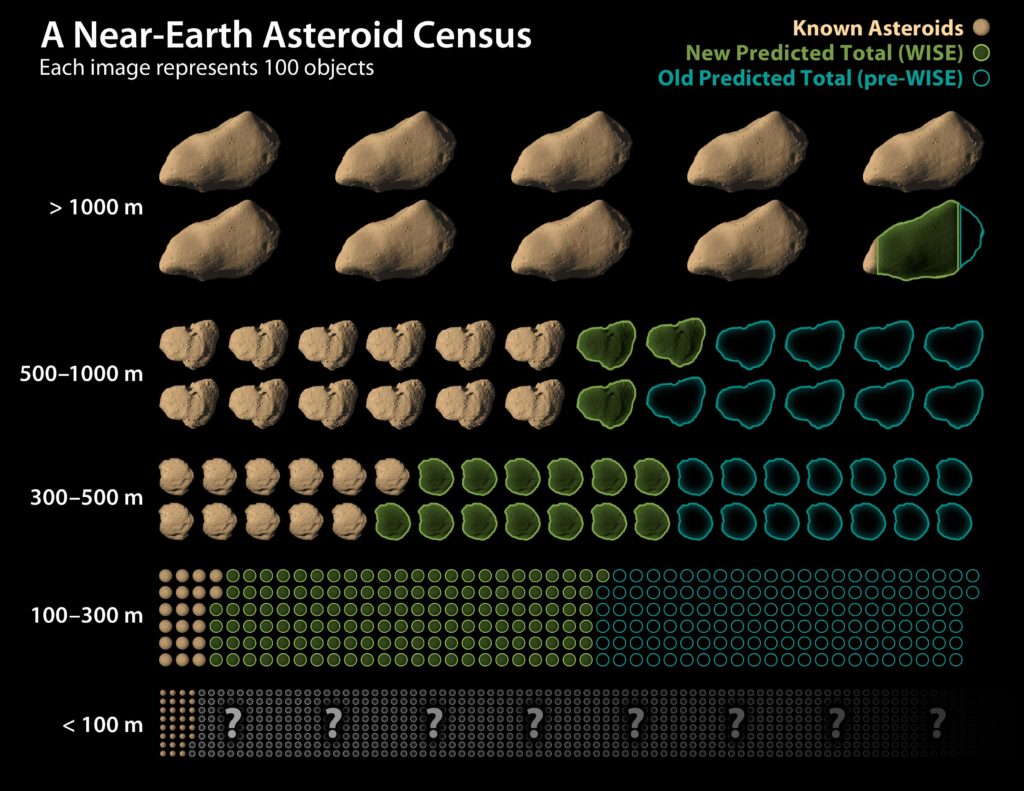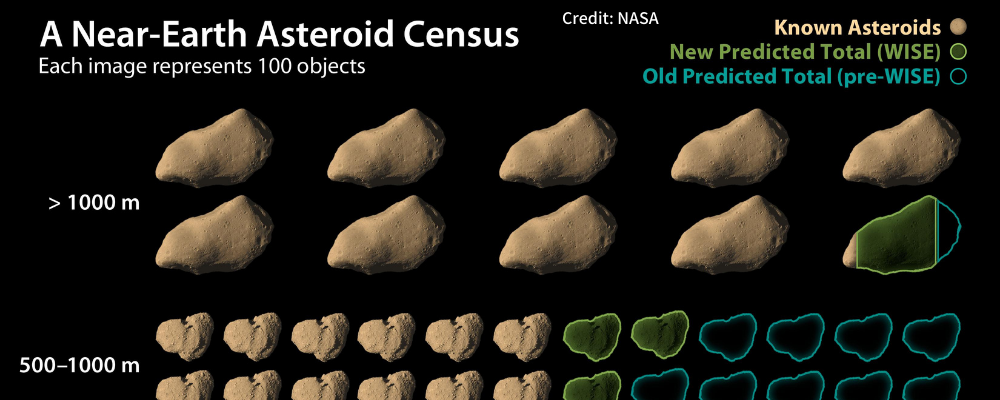Planetary Defense プラネタリーディフェンス というのはあまり聞きなれない言葉ですが、直訳すると 惑星防衛 という意味です。
宇宙空間には小惑星や岩石が漂っていますが、その中でも地球に衝突する可能性のあるものを発見し、何らかの対策を講じることを言うようです。
その惑星防衛について知っておくべき 10 のことと題して NASA の Jet Propulsion Laboratory (JPL) ジェット推進研究所 が解説記事を出しています。
10 Things You Should Know About Planetary Defense
ここではその9番目と10番目の話題について英文記事を読み解いていきながら、その内容を見ていきたいと思います。
Contents
惑星防衛について知っておくべき 10 のこと #9 & #10
9.地球近傍小惑星を間近で観察・研究する
現在 NASA では OSIRIS-REx と呼ばれるミッションを遂行中で、そのミッションでは地球近傍小惑星である Bennu を間近で観察・研究しています。
小惑星 Bennu については こちらの解説記事 もご参考。
There’s currently a NASA mission called OSIRIS-REx studying a near-Earth object up close – an asteroid named Bennu. Scientists recently calculated that this asteroid has a 1 in 2,700 chance of hitting Earth in the late 22nd century (that’s over 150 years away for now), but it has no chance of impacting any time before then.
NASA | 10 Things You Should Know About Planetary Defense より引用
この小惑星 Bennu が 22 世紀後半に地球に衝突する確率は 2,700 分の 1 であると科学者が見積もっているようですが、それより前に衝突する可能性は無いようです。
この ORISIS-REx ミッションでは現在、小惑星 Bennu の上空を周回しながら着陸してサンプルを採集するための準備をしており、2023 年に地球に戻る計画です。
Right now, OSIRIS-REx is orbiting the asteroid and studying its surface to prepare to take a sample and return it to Earth in 2023. The spacecraft is also studying a phenomenon called the Yarkovsky effect – which is a small force that shifts the asteroid’s orbit slightly as its Sun-heated surface radiates heat back into space. By studying Bennu close-up with OSIRIS-REx, scientists will be able to understand just how much heat is being radiated from the various parts of the asteroid, which will help them ultimately better understand the Yarkovsky effect and better predict Bennu’s orbit and its possible hazard to Earth.
NASA | 10 Things You Should Know About Planetary Defense より引用
このミッションの宇宙探査船では、Yarkovsky 効果と呼ばれる現象についても研究中で、これは、太陽の熱で温められた表面がそのエネルギーを宇宙空間に再放出する過程でその小惑星の軌道を少し動かす小さな力のことです。
ORISIS-REx ミッションを通じて Bennu を間近で観察・研究することによって、この小惑星の様々な表面からどの程度の熱エネルギーが放出されているのか理解が進み、Yarkovsky 効果のより深い解明と Bennu の軌道のよりよい予測が得られ、地球への衝突の予測精度の向上にも貢献するようです。

10.小惑星の軌道を逸らす
小惑星の衝突というのは、我々が避けることができる唯一の自然災害と言えるでしょう―問題となり得る小惑星を特定し、その軌道を逸らすミッションを発動させる十分な時間が与えられているのであれば。
Asteroid impacts are the only potentially preventable natural disaster – provided we spot the threatening asteroid with enough lead time to launch a mission into space to deflect it. NASA and its partners are studying several different approaches to deflecting a hazardous asteroid. The most advanced of these techniques is called a kinetic impactor, and a mission to demonstrate this technology is called the Double-Asteroid Redirection Test (DART), is slated to launch in 2021.
NASA | 10 Things You Should Know About Planetary Defense より引用
NASA とそのパートナーは脅威をもたらしうる小惑星の軌道を逸らすためのいくつかの方法を研究中とのことです。
その中で最も研究が進んでいる技術は kinetic impactor と呼ばれるもので、直訳するのであれば 動力学的衝突体 と言ったものです。
そしてこの技術を実演するための Double-Asteroid Redirection Test (DART) と呼ばれるミッションが 2021 年に実行される予定です。
be slated to ~ は ~する予定である という意味です。
もちろんこの実験では地球にリスクをもたらしうる小惑星の軌道にはちょっかいを出したりはしません。
Of course, we aren’t going to meddle with the orbit of an asteroid that could pose a risk to Earth for a test. The target for DART is Didymos B, the moon of a larger asteroid, called Didymos A. The Smart Car-sized DART spacecraft will slam into the football-stadium-sized Didymos B at a speed of 13,000 mph (22,000 kph) to not only confirm the robustness of the targeting system, but also to see how much the collision changes the asteroid moon’s orbit around Didymos A. Scientists have determined B’s orbit around A from the ground, and will then measure the orbit again after the DART collision to see how much the orbit has changed. That will tell us how much the kinetic impactor could change an asteroid’s path around the Sun if we needed to do so.
NASA | 10 Things You Should Know About Planetary Defense より引用
DART ミッションのターゲットは Didymos B という、より大きな小惑星 Didymos A の衛星です。
小型車程度の大きさの DART の宇宙船が、フットボールのスタジアム程度の大きさの Didymos B に時速 13,000 マイル(時速 22,000 キロメートル)のスピードで衝突し、ターゲットがどれだけ頑丈なのかを確かめるだけではなく、Didymos A を周回する衛星の軌道が衝突によってどれだけ変化するのかも観測します。
研究者は A を周回する B の軌道を A の地表から決定しており、DART の衝突の後でまた軌道を測定することでその軌道がどれだけ変化したのかを観測するのです。
これによって、もしわれわれがそうしなければならない時には、 太陽を周回する小惑星の軌道を kinetic impactor によってどれだけ変えることができるのかについて知ることができるのだそうです。
meddle with で ちょっかいを出す・おせっかいを焼く・干渉する という意味です。
そのようなミッションを発動する必要がないことを祈るばかりですが、もしもの時のために備えて研究は進められているのですね。
If a hazardous asteroid is found a decade or more before a potential impact, there would likely be time to launch a deflection mission to the asteroid, and we would only need to shift its orbit by just a bit – just enough to make it cross Earth’s orbit only about 10 minutes “late,” so to speak – to avoid the collision with our planet.
NASA | 10 Things You Should Know About Planetary Defense より引用
衝突の可能性のあるタイミングよりも 10 年あるいはそれ以上前に危険な小惑星が発見されていれば、その軌道を逸らすためのミッションを発動する時間があると言えそうです。
そして地球への衝突を避けるにはその軌道をほんの少し―地球の軌道を通過するのを、言うなれば 10 分でも、遅くできればそれでよし―ずらすだけでよいのです。
so to speak は 言わば・言うなれば という意味です。
まとめ
衝突の恐れのある小惑星の軌道を逸らす研究も進められているのですね。
まるで映画のアルマゲドンのような話ですが、万が一に備えて準備しておくことは大切ですね。
聞きなれない専門用語はいくつかありますが、英文としても素直な文章で読みやすかったのではないかと思います。
こういう読解を続けて行くと英文に慣れてきて内容も理解しやすくなってきますね!

